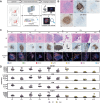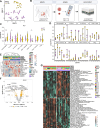Mapping the complexity and diversity of tertiary lymphoid structures in primary and peritoneal metastatic gastric cancer
- PMID: 38955417
- PMCID: PMC11218001
- DOI: 10.1136/jitc-2024-009243
Mapping the complexity and diversity of tertiary lymphoid structures in primary and peritoneal metastatic gastric cancer
Abstract
Background: Tertiary lymphoid structures (TLSs) are thought to stimulate antitumor immunity and positively impact prognosis and response to immune checkpoint blockade. In gastric cancers (GCs), however, TLSs are predominantly found in GC with poor prognosis and limited treatment response. We, therefore, hypothesize that immune cell composition and function of TLS depends on tumor location and the tumor immune environment.
Methods: Spatial transcriptomics and immunohistochemistry were used to characterize the phenotype of CD45+ immune cells inside and outside of TLS using archival resection specimens from GC primary tumors and peritoneal metastases.
Results: We identified significant intrapatient and interpatient diversity of the cellular composition and maturation status of TLS in GC. Tumor location (primary vs metastatic site) accounted for the majority of differences in TLS maturity, as TLS in peritoneal metastases were predominantly immature. This was associated with higher levels of tumor-infiltrating macrophages and Tregs and less plasma cells compared with tumors with mature TLS. Furthermore, mature TLSs were characterized by overexpression of antitumor immune pathways such as B cell-related pathways, MHC class II antigen presentation while immature TLS were associated with protumor pathways, including T cell exhaustion and enhancement of DNA repair pathways in the corresponding cancer.
Conclusion: The observation that GC-derived peritoneal metastases often contain immature TLS which are associated with immune suppressive regulatory tumor-infiltrating leucocytes, is in keeping with the lack of response to immune checkpoint blockade and the poor prognostic features of peritoneal metastatic GC, which needs to be taken into account when optimizing immunomodulatory strategies for metastatic GC.
Keywords: Adenocarcinoma; B cell; Gastric Cancer; Immunosuppression; Tumor microenvironment - TME.
© Author(s) (or their employer(s)) 2024. Re-use permitted under CC BY-NC. No commercial re-use. See rights and permissions. Published by BMJ.
Conflict of interest statement
Competing interests: None declared.
Figures




References
MeSH terms
LinkOut - more resources
Full Text Sources
Medical
Research Materials
Miscellaneous
